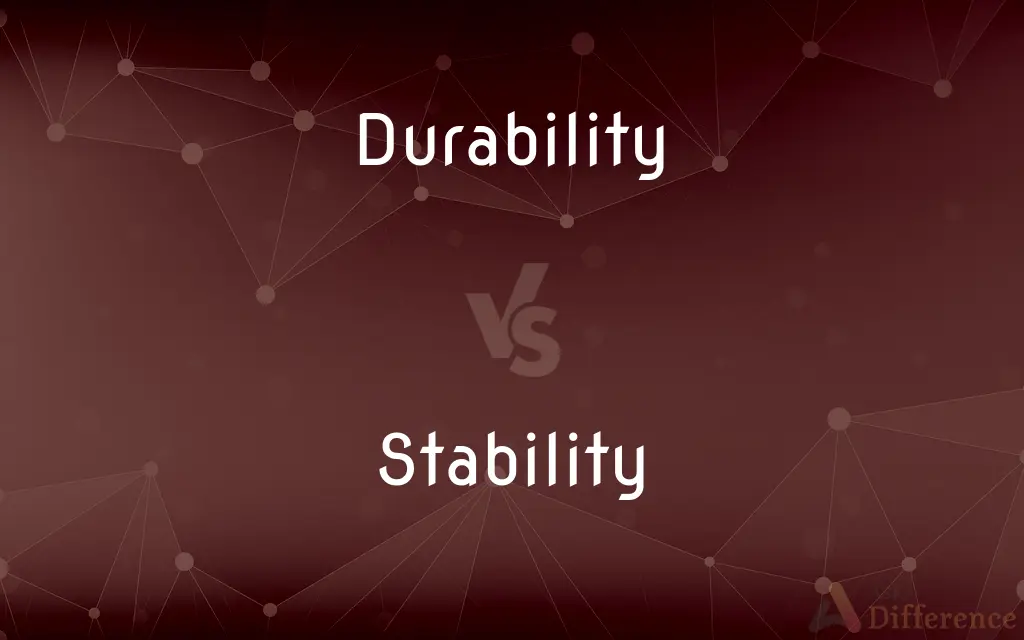Durability vs. Stability — What's the Difference?
By Fiza Rafique & Maham Liaqat — Updated on March 25, 2024
Durability refers to the ability of a material to withstand wear, pressure, or damage, while stability is about an object's ability to maintain its state or equilibrium under external forces.

Difference Between Durability and Stability
Table of Contents
ADVERTISEMENT
Key Differences
Durability is concerned with the longevity and resistance of materials or structures against environmental factors, physical stress, or degradation over time. Whereas stability focuses on an object’s or system’s ability to remain unchanged, balanced, or in a steady state when subjected to external forces or changes in conditions. This difference highlights durability as a measure of time-based resistance and stability as a measure of balance or constancy.
Durability is crucial in the selection of materials for construction, manufacturing, and product design, ensuring that the chosen materials can endure the intended use and environmental conditions without significant deterioration. On the other hand, stability is key in engineering, architecture, and physics to ensure that structures, systems, or algorithms perform reliably under a variety of conditions, maintaining their intended form or function.
The assessment of durability often involves testing for wear, corrosion, fatigue, and other forms of degradation to predict how a material or product will age or fail over time. In contrast, evaluating stability may involve analyzing balance, equilibrium, resistance to tipping or collapsing, and the ability to return to an original state after being disturbed.
Durability is enhanced by the use of high-quality materials, protective coatings, and design strategies that minimize stress and environmental impact. Stability, however, is achieved through careful design that considers the center of gravity, structural integrity, and the use of elements that counteract potential disturbances or forces.
Durability and stability, while distinct in focus, are complementary attributes in many fields. A durable structure that can withstand years of use must also be stable to remain functional and safe, while a stable system that can maintain its state under stress benefits from durable components to ensure its longevity.
ADVERTISEMENT
Comparison Chart
Focus
Resistance to wear, pressure, or damage
Ability to maintain state or equilibrium
Key Consideration
Longevity and resistance to environmental conditions
Balance, equilibrium, and resistance to external forces
Field Relevance
Construction, manufacturing, product design
Engineering, architecture, physics
Evaluation
Testing for wear, corrosion, fatigue
Analyzing balance, equilibrium, structural integrity
Enhancement
Use of high-quality materials, protective coatings
Careful design, considering center of gravity
Compare with Definitions
Durability
Capability to withstand environmental conditions.
The paint's durability against harsh sunlight prevents fading.
Stability
Capability to remain unchanged over time.
The chemical stability of the substance makes it safe for long-term storage.
Durability
Strength in resisting corrosion and decay.
Stainless steel is chosen for its durability and resistance to rust.
Stability
The ability to maintain balance or equilibrium.
The stability of the tower is ensured by its wide base.
Durability
Ability to endure physical stress without significant damage.
The bridge’s durability was tested by decades of heavy traffic.
Stability
Firmness in position or structure.
The table’s stability is critical to support heavy loads.
Durability
Resistance to wear and tear over time.
The durability of this flooring is unmatched, showing no signs of wear even after years.
Stability
Consistency of performance under varying conditions.
The software’s stability is crucial for critical applications.
Durability
Longevity of a product or material.
The smartphone’s durability was a key selling point, surviving drops and spills.
Stability
Resistance to change in state under external forces.
The boat’s design offers stability in rough waters.
Durability
Durability is the ability of a physical product to remain functional, without requiring excessive maintenance or repair, when faced with the challenges of normal operation over its design lifetime. There are several measures of durability in use, including years of life, hours of use, and number of operational cycles.
Stability
Resistance to change, deterioration, or displacement.
Durability
Capable of withstanding wear and tear or decay
A durable fabric.
Stability
Constancy of character or purpose; steadfastness.
Durability
Made to withstand repeated use over a relatively long period, usually several years or more
Durable goods such as washing machines and dryers.
Stability
Reliability; dependability.
Durability
Able to perform or compete over a long period, as by avoiding or overcoming injuries
A durable fullback.
Stability
The ability of an object, such as a ship or aircraft, to maintain equilibrium or resume its original, upright position after displacement, as by the sea or strong winds.
Durability
Lasting; stable
A durable friendship.
Stability
Roman Catholic Church A vow committing a Benedictine monk to one monastery for life.
Durability
A good or product made to withstand repeated use over a relatively long period, usually several years or more
Tracked the orders for automobiles and other durables.
Stability
The condition of being stable or in equilibrium, and thus resistant to change.
This platform offers good stability
Durability
Permanence by virtue of the power to resist stress or force.
Stability
The tendency to recover from perturbations.
Emotional stability
Durability
The state or quality of being durable; the power of uninterrupted or long continuance in any condition; the power of resisting agents or influences which tend to cause changes, decay, or dissolution; lastingness.
A Gothic cathedral raises ideas of grandeur in our minds by the size, its height, . . . its antiquity, and its durability.
Stability
The state or quality of being stable, or firm; steadiness; stableness; firmness; strength to stand without being moved or overthrown; as, the stability of a structure; the stability of a throne or a constitution.
Durability
Permanence by virtue of the power to resist stress or force;
They advertised the durability of their products
Stability
Steadiness or firmness of character; firmness of resolution or purpose; the quality opposite to fickleness, irresolution, or inconstancy; constancy; steadfastness; as, a man of little stability, or of unusual stability.
Stability
Fixedness; - as opposed to fluidity.
Since fluidness and stability are contrary qualities.
Stability
The quality or attribute of being firm and steadfast
Stability
A stable order
Stability
The quality of being free from change or variation
Common Curiosities
What does stability mean?
Stability refers to the ability of an object or system to maintain its state, balance, or equilibrium under external forces or conditions.
Can a material be durable but not stable?
Yes, a material can be resistant to wear and damage (durable) but may not maintain its shape or position (stable) under force.
Why is stability important in structures?
Stability is crucial for safety and reliability, ensuring that structures remain upright, balanced, and functional under various conditions.
Are there standard tests for durability?
Yes, there are various standard tests for assessing durability, including wear resistance, corrosion testing, and fatigue testing.
How does durability affect a product's lifespan?
Higher durability often leads to a longer lifespan for products by resisting physical stress, environmental conditions, and degradation.
Is stability related to balance?
Yes, stability often involves the ability to maintain balance or equilibrium, especially in physical structures.
What is durability?
Durability is the capacity of a material or product to withstand wear, pressure, or damage over time.
How can stability be assessed in software systems?
Stability in software is assessed by testing the system’s performance under various conditions and loads to ensure consistent operation.
Can stability be improved in an existing structure?
Stability can be improved with modifications like adding support, redistributing weight, or using stabilizing elements.
How do environmental conditions affect durability?
Environmental conditions like moisture, temperature fluctuations, and sunlight can accelerate degradation, affecting durability.
Can a product be too durable or too stable?
Overemphasis on durability or stability can lead to increased cost or unnecessary weight; balance in design is key.
Does the design play a role in both durability and stability?
Yes, design decisions significantly impact both the durability and stability of products, structures, and systems.
What is the relationship between durability and sustainability?
Durable products contribute to sustainability by reducing the need for frequent replacements, thus conserving resources and reducing waste.
How is stability measured?
Stability is measured through analyses of balance, structural integrity, and the ability to resist or recover from disturbances.
What role does material choice play in durability?
The choice of material is crucial for durability, as different materials have varying levels of resistance to stress and environmental factors.
Share Your Discovery

Previous Comparison
Aggressive vs. Combative
Next Comparison
Argue vs. RowAuthor Spotlight
Written by
Fiza RafiqueFiza Rafique is a skilled content writer at AskDifference.com, where she meticulously refines and enhances written pieces. Drawing from her vast editorial expertise, Fiza ensures clarity, accuracy, and precision in every article. Passionate about language, she continually seeks to elevate the quality of content for readers worldwide.
Co-written by
Maham Liaqat













































